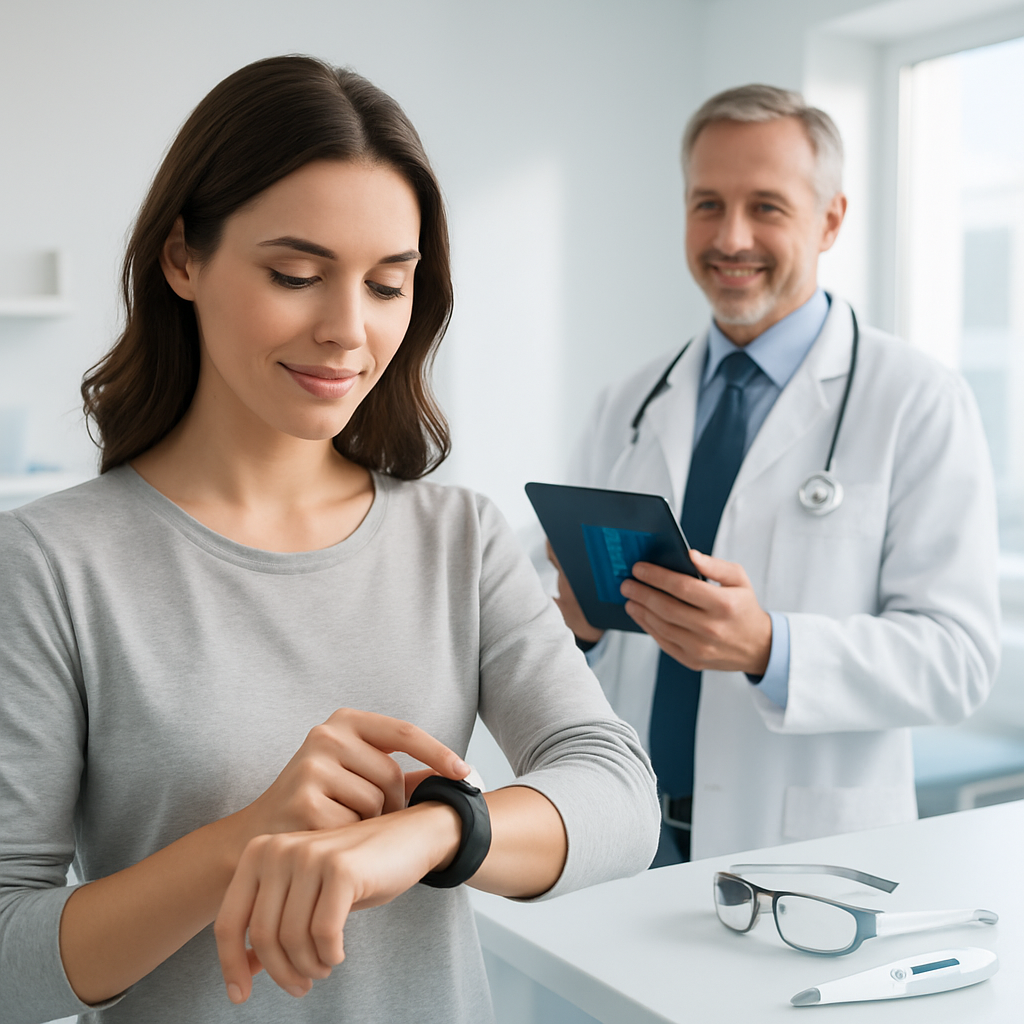The Future of Wearable Technology in Everyday Healthcare

Wearable health technology has come a tremendous distance from the early days of clunky pedometers that barely worked half the time. Remember those basic step counters from the 90s that would register a “step” if you so much as tapped them on a table? Today’s health wearables make those devices look like ancient artifacts, offering sophisticated monitoring capabilities that would have seemed like science fiction just fifteen years ago.
The healthcare landscape is rapidly transforming as these devices move from simple fitness trackers to legitimate medical tools. What began as basic step counters and heart rate monitors has evolved into sophisticated systems capable of detecting irregular heartbeats, monitoring blood oxygen levels, and even performing basic ECG readings all from your wrist or clothing.
From Fitness Trackers to Medical Devices
The first generation of modern wearables like the original Fitbit (2009) and early Jawbone UP bands primarily counted steps and estimated calories burned. Compare those to today’s Apple Watch Series 9 or the latest Fitbit Sense 2, which can measure blood oxygen saturation, detect atrial fibrillation, and even notify emergency contacts if you’ve fallen and aren’t responding.
“I still have my original Garmin Forerunner from 2006 in a drawer somewhere,” says Dr. Michael Chen, cardiologist at Boston Medical Center. “The difference between that and what my patients wear now is night and day. We’re getting medical-grade data from consumer devices.”
This evolution represents more than just technological advancement it’s a fundamental shift in how we approach personal health monitoring. The gap between consumer health tech and professional medical equipment continues to narrow.
Samsung’s Galaxy Watch recently received FDA clearance for sleep apnea detection, while the Apple Watch has been cleared for atrial fibrillation notification since 2018. These aren’t just cool features they’re potentially life-saving capabilities that previously required expensive medical equipment and overnight stays in sleep labs.
The integration is happening both ways. Traditional medical device companies like Medtronic and Abbott have taken cues from consumer tech, making their continuous glucose monitors and heart monitors more user-friendly and smartphone-compatible. The Dexcom G7 glucose monitor, for instance, now communicates directly with smartphones and smartwatches, allowing diabetics to check their blood sugar as easily as checking the time.
But these advancements bring questions about accuracy and reliability. Consumer-grade devices still can’t match the precision of medical equipment, despite marketing claims. A 2022 study in JAMA Internal Medicine found that even the best consumer wearables had error rates between 5-15% for metrics like heart rate during vigorous activity.
The Preventive Health Revolution
Perhaps the most significant impact of health wearables isn’t in treating conditions but preventing them in the first place. Traditional healthcare has always been reactive you get sick, then you seek treatment. Wearables flip this model by providing continuous monitoring that can catch problems before they become serious.
Take the case of James Patel, a 58-year-old software engineer who never suspected he had a heart condition. “My Apple Watch kept giving me these irregular heartbeat notifications. I ignored them for a week thinking it was just a glitch the way my old Nike+ sensor used to randomly lose connection. Eventually, I showed my doctor, and they diagnosed atrial fibrillation. I had no symptoms at all.”
Stories like James’s are becoming increasingly common. A 2023 Stanford study followed 419,000 Apple Watch users over two years and found that those who received irregular heartbeat notifications had a 5x higher likelihood of being diagnosed with cardiac issues compared to non-users.
The data collection capabilities of these devices go far beyond what any doctor could gather during occasional check-ups. Your primary care physician might take your blood pressure once every six months, but a modern smartwatch tracks your heart rate, activity level, and sleep patterns continuously, building a comprehensive picture of your health over time.
This continuous monitoring creates opportunities for early intervention. Imagine your doctor receiving an alert when your blood pressure has been trending upward for two weeks, rather than discovering it during your annual physical when it’s already become hypertension requiring medication.
Several health systems are already experimenting with this model. The Mayo Clinic launched a program in 2022 allowing patients to share data from their Apple Watches and Fitbits directly with their electronic health records. Doctors can then review this information during appointments or set alerts for concerning patterns.
The potential cost savings are enormous. A 2021 analysis by the RAND Corporation estimated that widespread adoption of preventive health monitoring through wearables could reduce U.S. healthcare costs by up to $200 billion annually by 2030, primarily through earlier interventions for chronic conditions like diabetes and heart disease.
Of course, the preventive model depends on users actually wearing their devices consistently. The abandonment rate for fitness trackers has historically been high around 30% of users stop wearing them within six months, according to consumer research firm NPD Group. But medical-grade devices with tangible health benefits show much better retention rates, closer to 80% for devices like continuous glucose monitors.
The accessibility of these technologies remains uneven. While basic fitness trackers have become affordable (you can get a decent Xiaomi Mi Band for under $30 now, compared to the $100+ price tags of early Fitbits), advanced health features remain concentrated in premium devices costing $300 or more.
This creates a potential healthcare divide where those who could most benefit from preventive monitoring often older adults with lower incomes and higher chronic disease risks have the least access to it. Some insurance companies have begun subsidizing wearables for high-risk patients, but these programs remain limited.
I’ve been testing health wearables since the original Pebble watch in 2013, and the progress has been remarkable. My current rotation includes an Oura Ring for sleep tracking and an Apple Watch for daytime use. The data they provide has genuinely changed my health habits I go to bed earlier after seeing my sleep scores drop, and I take more walking breaks after noticing how sedentary my workdays can be.
But the future holds even more promise. Emerging technologies like continuous blood pressure monitoring without a cuff, non-invasive glucose monitoring for diabetics, and sweat analysis for hydration and electrolyte balance are all in advanced development stages. Companies like Rockley Photonics are working on spectroscopy-based sensors that can measure blood glucose, alcohol levels, and various biomarkers using light-based technology that could fit in a watch.
The real game-changer won’t be any single measurement but the holistic health picture created when all these data points are analyzed together. Machine learning algorithms can spot patterns humans might miss, potentially identifying subtle signs of developing conditions weeks or months before conventional testing would catch them.
Privacy and data security remain significant concerns. Health data is among the most sensitive personal information, and wearable companies haven’t always been transparent about how this data is used. The regulatory framework is still catching up devices that don’t make specific medical claims often fall outside FDA oversight, creating a gray area where consumer protection is limited.
The integration of wearables with formal healthcare systems presents both technical and cultural challenges. Electronic health record systems weren’t designed to handle the massive data streams generated by continuous monitoring devices. And many physicians are skeptical about the reliability of consumer device data or feel overwhelmed by the prospect of reviewing it.
Dr. Sarah Johnson, a primary care physician in Chicago, expresses a common sentiment: “I want to support patients using these devices, but I don’t have time to review weeks of heart rate data during a 15-minute appointment. We need better systems to flag meaningful patterns and integrate this information usefully.”
Despite these challenges, the trajectory is clear. Wearable health technology is transforming from a fitness accessory to an essential component of modern healthcare. The devices we wear today will seem as primitive as those first-generation pedometers when compared to what’s coming in the next decade.
For patients, healthcare providers, and technology companies alike, the future of everyday healthcare involves a collaborative relationship where wearable technology serves as a bridge between periodic doctor visits, providing continuous insights that make healthcare more preventive, personalized, and effective than ever before.


